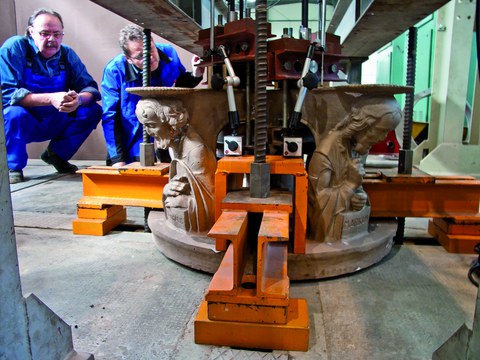Load bearing capacity of a bell crown
Table of contents
Project data
| Titel | Title Bruchfestigkeit einer Glockenkrone | Load bearing capacity of a bell crown Auftraggeber | Client G. Donath, Dombaumeister Meißen Zeitraum | Period 09.2010 Leiter | Project Manager Dr.-Ing. Torsten Hampel Projektpartner | Project Partners Prof. Dr.-Ing. A. Nietzold Durchführung | Project Executors Ludwig Beier, Tino Jänke, Heiko Wachtel |
Report in the yearbook 2010
Breaking strength of a bell crown

During the test
In the fall of 2010, a very special component was examined in the Otto Mohr Laboratory: the new crown for the St. John's bell of Meissen Cathedral. The St. John's bell, cast in 1929, has a diameter of 220 centimeters, weighs almost 8,000 kilograms and is considered by experts to be the most figurative in the world. It had crashed into the northwest tower in 1977 and got wedged in the bell tower. After it was provisionally re-hung, it only rang out for a few minutes on high church holidays for safety reasons. In the course of the restoration work, the bell was to receive a new crown, so that it could perhaps ring out in all its glory as early as Christmas 2010.
In April 2010, the new crown had been cast according to a historical method. However, examination of the bell crown with X-rays, ultrasound and isotope radiation had revealed small cavities in the evangelists. Such voids are not uncommon in such geometrically complex shapes. However, in order to assess their influence on the load-bearing capacity of the bell crown, it should be subjected to a load test in the Otto Mohr laboratory. It is not possible to completely avoid these small air inclusions, since shrinkage will always occur in the casting process used.
The loading regime and maximum load level were determined in consultation with the client. The load was to be introduced according to the real situation in the structure. There, the four apostles are stressed by high tensile forces. For this purpose, the base plate of the bell crown was anchored to the clamping field in the laboratory. A frame of steel sections was constructed above the crown to serve as an abutment. Four synchronized presses were then used to simultaneously apply tensile forces to the horizontal cross of the bell crown.
In a first step, the load was increased to the previously agreed limit of 350 kN or 87.5 kN per press. This load level was achieved without any problems and without damaging the component under investigation. A second load was then agreed, in which the presses pressed directly against the yokes with 250 kN each. In this case, the bell crown was to be loaded until it broke. This test also went smoothly and it was demonstrated that the cast crown could withstand many times the required breaking load despite the diagnosed flaws.
